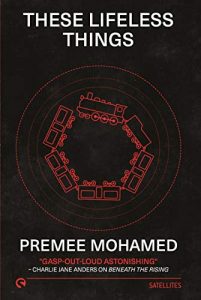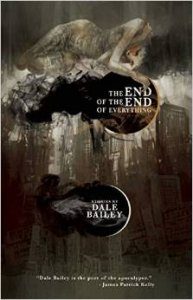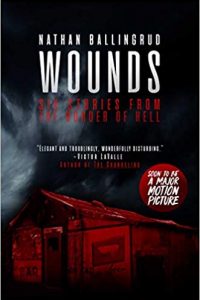Katharine Coldiron Reviews These Lifeless Things by Premee Mohamed
 These Lifeless Things, Premee Mohamed (Solaris Satellites 978-1-78618-448-1, $15.99, 176pp, tp) February 2021.
These Lifeless Things, Premee Mohamed (Solaris Satellites 978-1-78618-448-1, $15.99, 176pp, tp) February 2021.
These Lifeless Things by Premee Mohamed tantalizes with evocative ideas, excellent characterization, and beautiful language. It is a perfect story to tell in novella form, a snippet of a post-apocalyptic world where humanity has been defeated too many times to make sense of its struggle. Mohamed alternates the book’s narration between tense, hopeless diary entries and commentary by an anthropologist who has discovered the diary in question decades later. This isn’t a plot-driven tale; rather, it’s thematically rich, with layered backstory and worldbuilding which rewards a second read.
The two narrators are Emerson, the anthropologist, and Eva, the diarist. Emerson lives in a comfortable world not too different from our own (phones, computers, and other technology are mentioned), part of a team of scientists visiting a “siege city” on a research trip. Eva lives in a nightmarish combat zone, scavenging supplies from the destroyed city and eating human flesh to survive. The event that occupies both people is the Setback, a near-extinction of human life by extradimensional aliens – Eva is living through it and Emerson is studying it. The Setback “knocked the entire world back to the stone age and everything had to be recreated from scratch,” but many of its details remain fuzzy, decades later.
Eva faces deadly challenges and tries to root out a spy among her group. Eventually she discovers that the aliens have been kidnapping and holding children, and she assembles a plan to free them. She does this in spite of her fear and exhaustion and the near-certainty that she won’t survive. The story implies that this specific action allowed humanity to survive the Setback, and in this way and others, These Lifeless Things exhibits the power of implication rather than explanation. For example, the city in which the team is studying seems to be haunted, causing the researchers to sleepwalk and otherwise act strangely. These issues link to the threats of Eva’s world – statues and animals – which in turn link to the aliens. Mohamed never fully solidifies these links, but these suggestions, this seeming, add mood.
Despite this lack of clarity, the book is mesmerizing. Eva’s voice is finely tuned, at once despondent and determined, traumatized and yet loving, turning on a dime from humor to lyricism: “After the world ended I thought we would resemble the dusty movies of the eighties, you know, studs, spikes, leather. Instead we all look like extras from Fiddler on the Roof, our clothes worn-down, exhaustively beaten up at the riverside, mangled and hung in the sun.” Emerson is as moved by her as the reader is. Once Eva finds a purpose (rescuing the children), the book’s tone changes a little, becomes more focused but also more sentimental. This is not a change for the better. As a record of an apocalyptic time and the person studying it decades later, These Lifeless Things is fascinating enough. It almost doesn’t need the plot that kicks in during its last third.
Plus, the conflict between Emerson and their team has interesting reverberations for our current moment. Emerson’s occupation as an anthropologist studying the Setback seems pointless to the team; they gather scientific data while Emerson reads and analyzes the journal and tries to map the city. As Damien, the leader of Emerson’s team, puts it:
All we can do now is use what happened for the future. That’s what I’m doing. Getting data to build better buildings, stronger foundations. Bunkers for war, to protect soldiers. Even better bombs. And what are you doing? Wallowing in the past with them, and bringing nothing into the future. What’s that worth?
Of course he’s wrong. Anyone with a grasp of epistemology knows that anthropology is just as valuable as hard science, and maybe more so when human behavior affects the outcome of a world-changing event. But it’s still difficult to study such things. As Emerson puts it, “Instead of the microscope of the world being trained on the Setback, everyone looked away.” Anthropological study of the COVID-19 pandemic does not sound too appealing, either, but how we lived during this time matters a lot to our future, if we are to have one.
Although Premee Mohamed’s vision of the apocalypse in These Lifeless Things is bleak, it is not as terrifyingly likely as other scenarios, and that makes this book a scary pleasure without being a chilling one. She upsets us only to a point. The core of the story is humanity and humanism – how critical it is that we study the former, feel the latter, and act as if both matter more than our individual safety. Hence, These Lifeless Things is an optimistic book, and a surprisingly heartfelt one.
Katharine Coldiron is the author of Ceremonials (Kernpunkt Press), an SPD fiction bestseller. Her work as a book critic has appeared in The Washington Post, The Believer, The Guardian, and many other places. She lives in California and at kcoldiron.com.
This review and more like it in the April 2021 issue of Locus.
 While you are here, please take a moment to support Locus with a one-time or recurring donation. We rely on reader donations to keep the magazine and site going, and would like to keep the site paywall free, but WE NEED YOUR FINANCIAL SUPPORT to continue quality coverage of the science fiction and fantasy field.
While you are here, please take a moment to support Locus with a one-time or recurring donation. We rely on reader donations to keep the magazine and site going, and would like to keep the site paywall free, but WE NEED YOUR FINANCIAL SUPPORT to continue quality coverage of the science fiction and fantasy field.
©Locus Magazine. Copyrighted material may not be republished without permission of LSFF.








